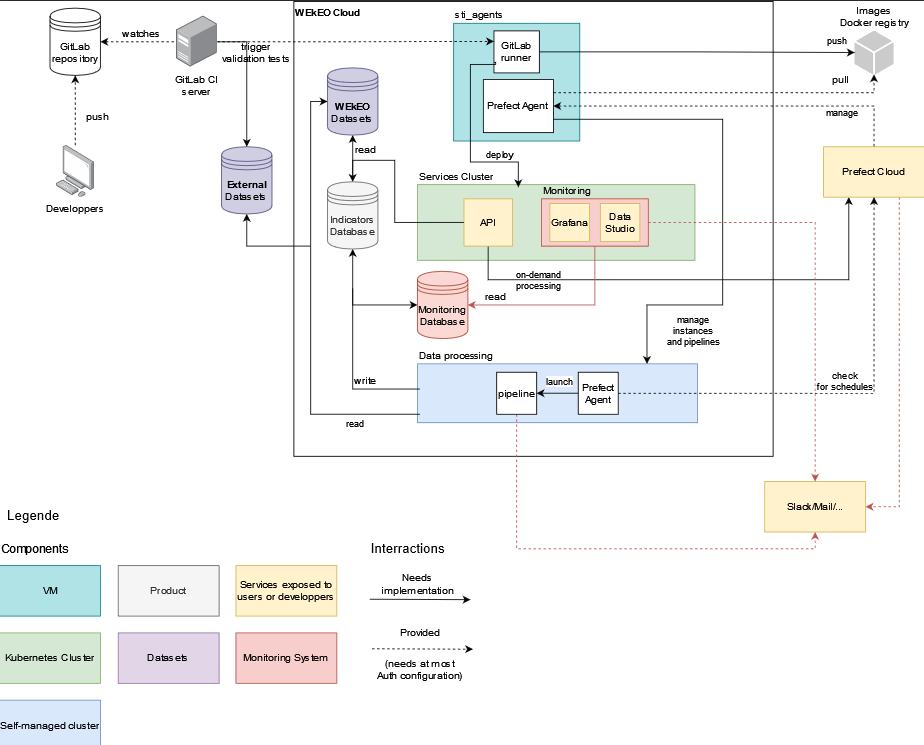Objectives of the service
The primary service developed is an online dashboard that monitors the environmental impact of large events, focusing on air pollution, vegetation trampling, and water turbidity. This service is intended to support long-term monitoring and provide a commercially viable solution compliant with ISO 20121 standards.
The objective of the project is :
-
To engage with a major players in the sector.
-
To validate the use of spatial data in the context of the large event organisation
-
To determinate the needs from the sector both in terms on thematic indicators and required resolution
Multiple prototypes were created for different events, each demonstrating various aspects of environmental monitoring.
Users and their needs
The feasibility study has enabled us to understand different typology of stakeholders and their needs from the world of sport events:
-
World Major events: these are the likes of Olympic games organizers.
-
Local major events: these include yearly or bi-yearly major events for a specific sport, similar to the UTMB (“Ultra Trail du Mont Blanc”, France) with whom we had the chance to develop a pilot service. There is an important need for accuracy, geographically and temporally.
-
World series events: this is the category that includes a series of events across the globe in different sites, such as the Tour de France or the World Rally Championships. This category is formed of a multiplication of long events (100km+) that appeal to many spectators and similarly to the previous category, requires a precise (geographical and temporal) mapping of the impact, in addition to a homogenous way of comparing different venues and impacts with the aim of creating a positive ecological transition of both the event itself and its image.
Service/ system concept
The diagram shows the technical platform that we are putting in place for the feasibility study.

The major features are:
-
Automated deployment: is a major feature that is enabled thanks to the use of Gitlab server and runner in addition to the Docker register.
-
Orchestration: Two levels of orchestration are put in place, the first one is triggered by data, where an external orchestrator fetch the new data from external sources at regular intervals, and trigger the execution of the corresponding processing chain. A second orchestration level is set amidst the required resources that are necessary to operate the platform (using Kubernetes). These two levels of orchestration allows a decoupling of core platform needs and on-demand resources triggered on an event basis (manual, data, etc.)
-
Monitoring and notifications: all deployed components are monitored as well as the data.
-
Scalability: the system is scalable by design thanks to its clustere
The proposed architecture and its high performance/scalability features are instrumental for the present feasibility study. Indeed, the proposed use of high resolution data, in complementary to the Copernicus and Sentinel data, will require significantly higher resources, due to the higher resolution but also the higher rate of required acquisition (daily acquisition to be as close as possible to the event).
Space Added Value
The following space assets are used:
-
Earth observation data from Copernicus missions, services and complementary data: optical imagery from Sentinel-2, thermal imagery from Landsat 8/9, air quality from Copernicus Atmosphere Monitoring Service
-
High resolution earth observation data from Planet commercial service
-
Copernicus Data Dissemination platforms such as WEkEO
Current Status
The viability of the project has been established through the feasibility study. Proofs-of-concept have been developed with engaged pilot users, validating the relevance and the added-value provided by the service. User feedback and requirements have been gathered to develop an operational service addressing the different identified user segments.



